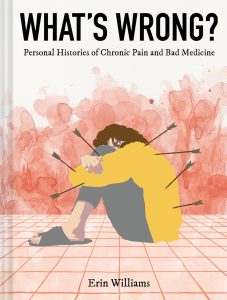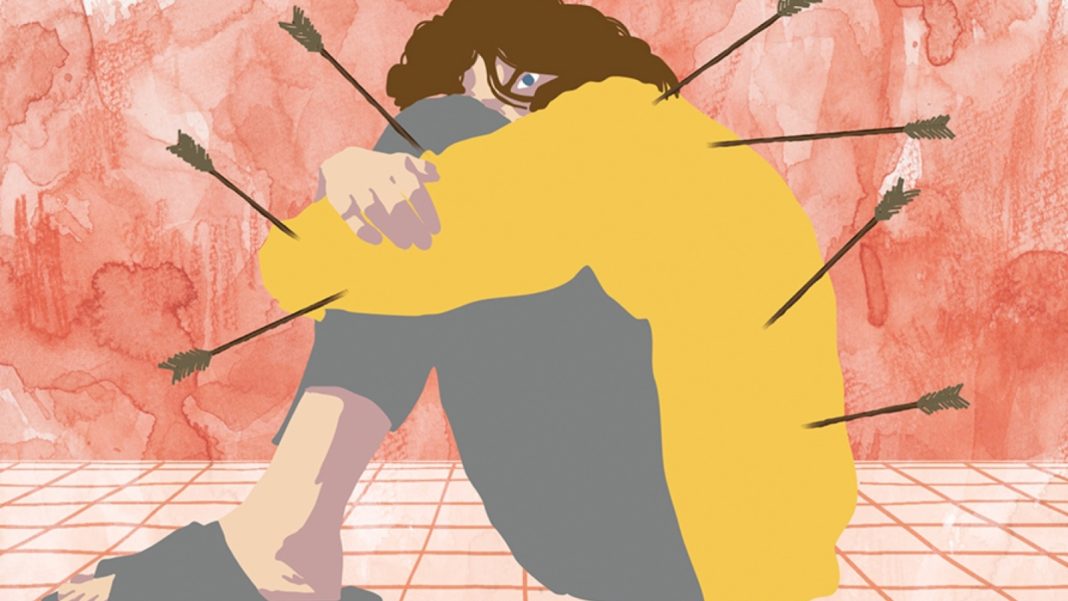
What’s Wrong?: Personal Histories of Chronic Pain and Bad Medicine
Writer/Artist: Erin Williams
Publisher: Abrams ComicArts
Publication Date: January 23, 2024
What do you do when your baseline pain is at the top of the scale for a non-disabled person? For millions of disabled people who suffer from chronic pain, getting appropriate treatment first requires getting physicians to believe that they’re in pain, which is a bigger and more difficult hurdle than it should be—especially for disabled people who are intersectionally marginalized in other ways. Because seeking effective care requires time, money, and, in most cases, inexhaustible determination, many people are edged out of even considering relief for what ails them.
This is the baseline for the five people whose experiences are chronicles in cartoonist Erin Williams’s new graphic novel, What’s Wrong?: Personal Histories of Chronic Pain and Bad Medicine, including Williams’s own experiences as a recovering addict with debilitating gastroenterological pain. In writing about her own body, Williams is vulnerable and candid, especially as she examines the variety of factors that led her to this point. Readers who liked her 2019 graphic novel, Commute: An Illustrated Memoir of Female Shame, will be just as drawn into this book.
But in What’s Wrong?, Williams doesn’t focus solely on her own experiences with chronic pain and disability. She notes that, per the CDC, 20 percent of Americans (50 million people) live with chronic pain, “making doctors appointments, shuffling from specialist to specialist, filling script after script, often spending their entire lives without meaningful relief. Most of them are people with uteruses.”
To that end, Williams also spotlights four other people, whom she talked to for three years as she wrote and illustrated What’s Wrong?. Representing an array of genders and ethnicities, those featured describe how Western medicine was predisposed to fail them and has done so spectacularly, but reaching out to other disabled people and practicing self-advocacy has also majorly impacted their individual lives.
Throughout, Williams presents research on how certain groups of people are more likely to suffer from and even die from ailments than others (read: white, assigned male at birth) with a higher likelihood of contracting these diseases because the latter are treated more aggressively and with more haste. For example, Jamaican-American Dee was diagnosed with bladder cancer after decades of doctors insisting her reproductive organs were causing her chronic pain even after a total hysterectomy and oophorectomy. Even after the tumor in her bladder was removed and she went through several rounds of chemo, her pain continued to worsen and the cancer eventually came back.
Williams notes, “Black people (regardless of gender assigned at birth) and people with uteruses of any race or ethnicity have significantly higher mortality rates for bladder cancer…. According to the American Cancer Society, Black people have the highest mortality rate and shortest survival of any racial or ethnic group for most types of cancer in the United States.”
To accompany these highly personal profiles and supporting research about why chronic pain is often dismissed as “phantom” or otherwise not as serious as what patients report, to the detriment of their quality and longevity of life, Williams inserts various illustrated diagrams and graphs in her abstract, color-blocked illustration style. The art in What’s Wrong? is uncomfortable to look at, especially because of how it’s interspersed among personal testimonies that are hard to read without feeling large swells of rage and despair. Williams is great at unflinchingly demanding readers’ attention, forcing them to acknowledge, absorb, and reconcile the hard topic at hand.
What’s Wrong? is a brilliant addition to the growing disability rights canon. Not only does it correctly position addiction as a medical diagnosis, rather than a moral one, but it examines how “miracles” are packaged and sold as drugs, surgeries, and other fixes that often make things worse for the majority of patients who just want to go for a single day without excruciating pain. It’s informative, descriptive, balanced, and sharp, balancing biting commentary with empathetic profiles and careful examination of how things can change for the betterment of all.
Whether you’re brand new to the topic of disabled community building and medical gaslighting or you’re well-versed, What’s Wrong? is an excellent addition to your library that’s worth multiple reads.
Final verdict: Buy







